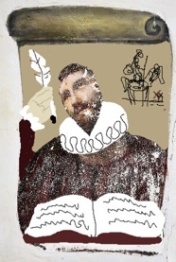 Named “the best literary work of all time” by the World Library, DON QUIXOTE by Miguel de Cervantes (1547-1616) tells the story of a man who envisions himself as a chivalrous knight and begins to view his life as a noble adventure. Published in the author’s native Spain in 1605 to immediate acclaim, a second part appeared a decade later.
Named “the best literary work of all time” by the World Library, DON QUIXOTE by Miguel de Cervantes (1547-1616) tells the story of a man who envisions himself as a chivalrous knight and begins to view his life as a noble adventure. Published in the author’s native Spain in 1605 to immediate acclaim, a second part appeared a decade later.
Here is an excerpt:
“Destiny guides our fortunes more favorably than we could have expected. Look there, Sancho Panza, my friend, and see those thirty or so wild giants, with whom I intend to do battle and kill each and all of them, so with their stolen booty we can begin to enrich ourselves. This is noble, righteous warfare, for it is wonderfully useful to God to have such an evil race wiped from the face of the earth.”
“What giants?” asked Sancho Panza.
“The ones you can see over there,” answered his master, “with the huge arms, some of which are very nearly two leagues long.”
“Now look, your grace,” said Sancho, “what you see over there aren’t giants, but windmills, and what seems to be arms are just their sails, that go around in the wind and turn the millstone.”
“Obviously,” replied Don Quixote, “you don’t know much about adventures.”
NOTE ON THE ABOVE ILLUSTRATION: In 1955, a publication in France (Les Lettres Françaises) commissioned Pablo Picasso (1881-1973) to create a painting for the cover of an edition celebrating the 350th anniversary of Don Quixote. In his brilliantly simple (or simply brilliant) illustration, Picasso captured the novel’s main characters and themes — Don Quixote, his horse Rocinante, his squire Sancho Panza, Sancho’s donkey Dapple, the windmills cited in the above excerpt, as well as the blazing sun of La Mancha.

We celebrate these masters from Spain — Miguel de Cervantes (from Alcalá de Henares) and Pablo Picasso (from Málaga). They continue to inspire, as evidenced by a recent entry in The Cecilia Prize, a contest established to honor Cecilia Gimenez, an amateur artist from Borja, Spain, whose restoration of a beloved fresco (Ecce Homo) has sparked controversy and conversation around the world. The entry, Ecce Quixote (shown at left), is by Gustavo Berocan of Brazil (Twitter @gugudadanews).


















